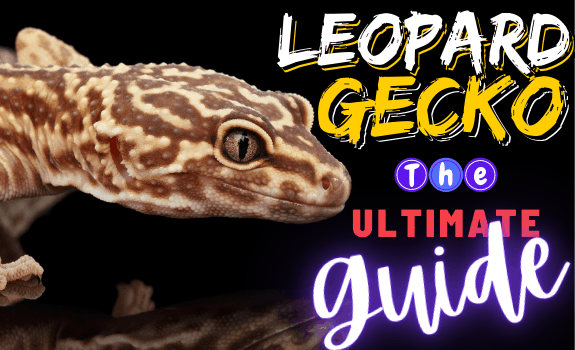Have you ever seen leopard geckos for sale at a pet store or reptile expo? Chances are, some of those adorable lizards carried morphs.
Every year, new and exciting genetic mutations and hereditary traits known as leopard gecko morphs pop up.
Morphs change a leopard gecko’s appearance. It can affect their color, pattern, or even their size! Morphs make for a more attractive and unique pet. That’s why the price of a leopard gecko varies from morph to morph. Many people choose a name for leopard gecko based on the morph too.
All of the complicated words and labels can be overwhelming, so we’re here to decode the jargon and simplify leopard gecko morphs.
In This Article
In-Short
- Leopard gecko morphs change the lizard’s appearance.
- Pet owners appreciate the beauty and peculiarity of leopard gecko morphs.
- Reptile breeders develop new leopard gecko morphs every year.
- Leopard geckos inherit morphs from one or both parents.
- There are currently over 25 well-known leopard gecko morphs.
- Some leopard gecko morphs cause health issues.
What Is a Leopard Gecko?
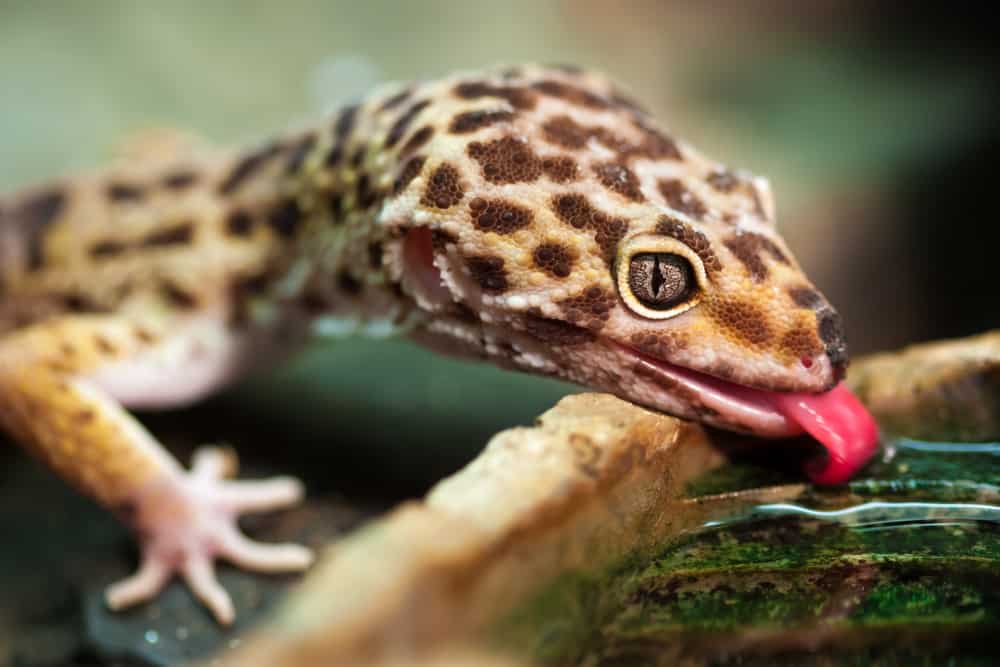
A leopard gecko is a small, nocturnal, ground-dwelling lizard that hails from the arid regions of Southwestern Asia.
Wild-type leopard geckos are dull yellow or tan. They have irregular, dark brown spots and white bellies. Their skin is rough and bumpy.
Leopard geckos have large eyes to help them see in the dark. They inhabit rocky crevices and caves. These little geckos live in loosely-formed colonies that emerge at night to hunt for insects.
Did you know that the wide mouth of these lizards can make them look like smiling? Check out the funny photos of leopard gecko smiles here to see how cute they can be!
What Is a Leopard Gecko Morph?
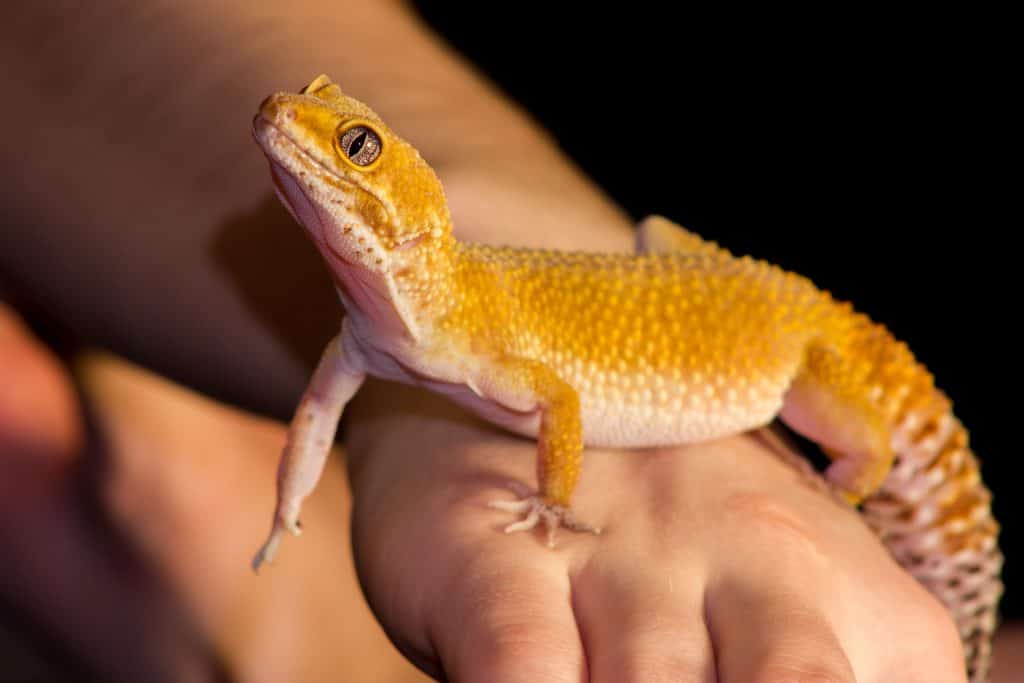
A leopard gecko morph is any genetic mutation or line-bred trait that changes the appearance of the animal.
Morphs can change the lizard’s:
- Size
- Color
- Pattern
Morphs can be a:
- Genetic Mutation – inherited from one or both parents. It is either present or not present.
- Line-bred Trait – appears at varying intensities and with no consistent appearance. For example, barely orange-tinged and neon orange geckos can both have the same trait: Tangerine. Traits are NOT guaranteed to pass on to all offspring.
- Bloodline – created by breeders from pre-existing line-bred traits who focus on one attribute. Most line-bred traits have numerous bloodlines. Blood and Mandarin are both bloodlines of the Tangerine trait.
- Combinations – Morphs with more than one genetic mutation, trait, or both. For example, the Raptor morph is a combination of the Tremper Albino and Eclipse morphs.
How Many Morphs Are There?
There are around 30 distinguished morphs. Within these morphs, there are dozens of combinations and bloodlines that vary in appearance.
In total, there are over 100 named morphs today. Breeders come up with new bloodlines and combinations every year. It can be hard to keep track!
Our list will identify the core mutations and traits. We will also identify some popular bloodlines and combinations within those core morphs.
Vocabulary
Before we begin, it’s essential that you understand the following key terms.
Allele – One of two pieces in a genetic locus. Offspring inherit one allele from each parent to form the genotype (appearance.)
Dominant – A dominant gene requires only one associated allele on the locus to change the animal’s appearance. Only one parent must carry the dominant gene.
Recessive – A recessive gene requires both associated alleles on the locus to change the animal’s appearance. Both parents must carry the recessive gene.
Homozygous – When both alleles on the locus are the same. The gene must be homozygous for the animal to display a recessive trait.
Heterozygous – When both alleles on the locus are different. The dominant allele on the locus determines the animal’s appearance, but it can carry a recessive allele and pass it to its offspring.
Incomplete Dominant – When the gene creates a blended appearance when the animal is heterozygous, or a super form when the animal is homozygous.
Ultimate Leopard Gecko Morph List
Here’s our comprehensive guide to common leopard gecko morphs.
Albino
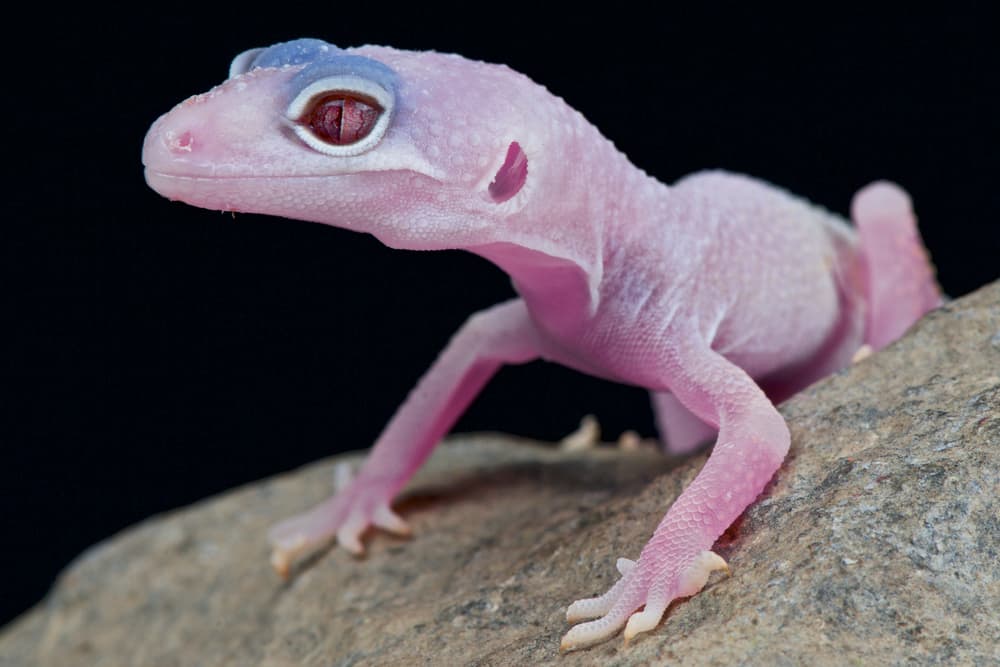
Albino leopard geckos are amelanistic. They lack melanin, the black pigment. Albino leopard geckos are primarily yellow, white, and tan.
Albinism is a recessive, inheritable genetic mutation. There are currently at least three recognized albino genes:
- Bell Albino
- Tremper or Texas Albino
- Las Vegas or Rainwater Albino
Combination morphs that utilize albinism include:
- Blazing Blizzard (Albino + Blizzard)
- Hybino (Albino + Hypo + Tangerine)
- Tangerine Albino (Albino + Tangerine)
- Sunrise (Albino + Tangerine + Blizzard)
- Sunglow (Albino + Super Hypo + Tangerine)
- Tremper Albino Specific:
- Raptor (Tremper Albino + Eclipse)
- Nova (Tremper Albino + Blizzard + Eclipse)
- Diablo Blanco (Tremper Albino + Blizzard + Eclipse)
- Aptor (Tremper Albino + Patternless + het for Eclipse)
- Ember (Tremper Albino + Eclipse + Murphy Patternless)
- Dreamsickle (Tremper Albino + Mack Snow + Eclipse + Enigma)
- Super Nova (Tremper Albino + Super Mack Snow + Eclipse + Enigma)
- Snowflake (Tremper Albino + Mack Snow + Eclipse + Murphy Patternless)
- Rainwater or Las Vegas Albino Specific:
- Typhoon (Las Vegas Albino + Eclipse)
- Cyclone (Las Vegas Albino + Eclipse + Patternless)
- Firewater or Lava (Rainwater Albino + Super Hypo + Tangerine)
- Bell Albino Specific:
- Radar (Bell Albino + Eclipse)
- Lavender Bell (Bell Albino + Lavender)
- White Knight (Bell Albino + Eclipse + Blizzard)
- Stealth (Bell Albino + Snow + Enigma + Eclipse)
- Super Stealth (Bell Albino + Super Snow + Enigma + Eclipse)
If you want to know more about the Albino leopard gecko, read our complete guide to the Albino morph here!
Baldy
Baldy leopard geckos have a patternless head. Baldy is a line-bred trait.
The only combination morph that includes the baldy trait is SHTCTB or Super Hypo + Tangerine + Carrot Tail + Baldy.
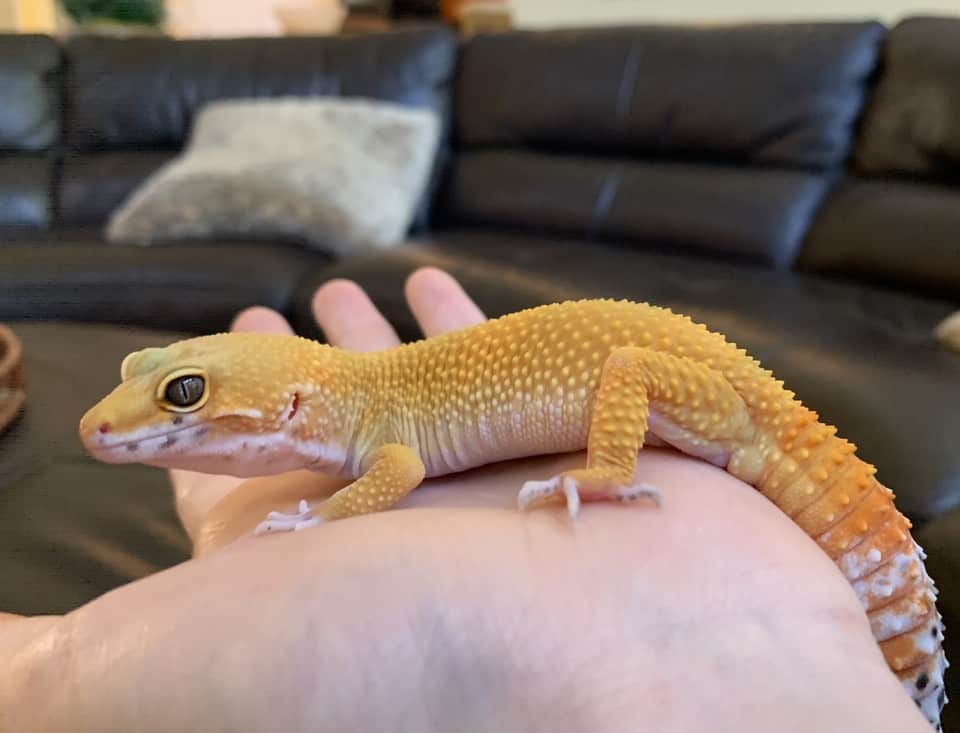
Blizzard
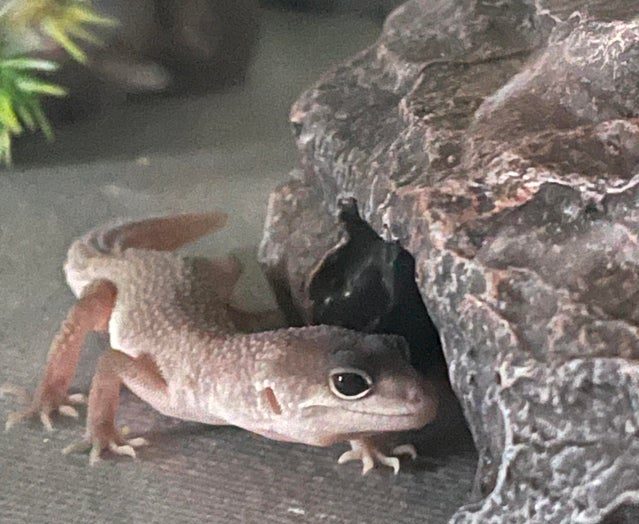
Blizzard is a recessive, inheritable genetic morph that results in a grey gecko with virtually no pattern. They have solid black eyes.
This morph is utilized as a base in a wide array of combination morphs, including:
- Sunset (Blizzard + Tangerine)
- Blazing Blizzard (Blizzard + Albino)
- Sunrise (Blizzard + Albino + Tangerine)
- White Knight (Blizzard + Bell Albino + Eclipse)
- Banana Blizzard (Blizzard + Murphy Patternless)
- Diablo Blanco (Blizzard + Tremper Albino + Eclipse)
- Diorite (Bloodline of Super Snow, possibly heterozygous for Blizzard)
Bold
Bold is a line-bred trait that results in markings that are darker than a normal leopard gecko’s.
Bold stripe is a combination of bold and striped traits.
Carrot Head
Carrot head is a line-bred trait that causes the base color on the leopard gecko’s head to be bright orange. The chocolate-colored spotty markings are still present.
Carrot Tail
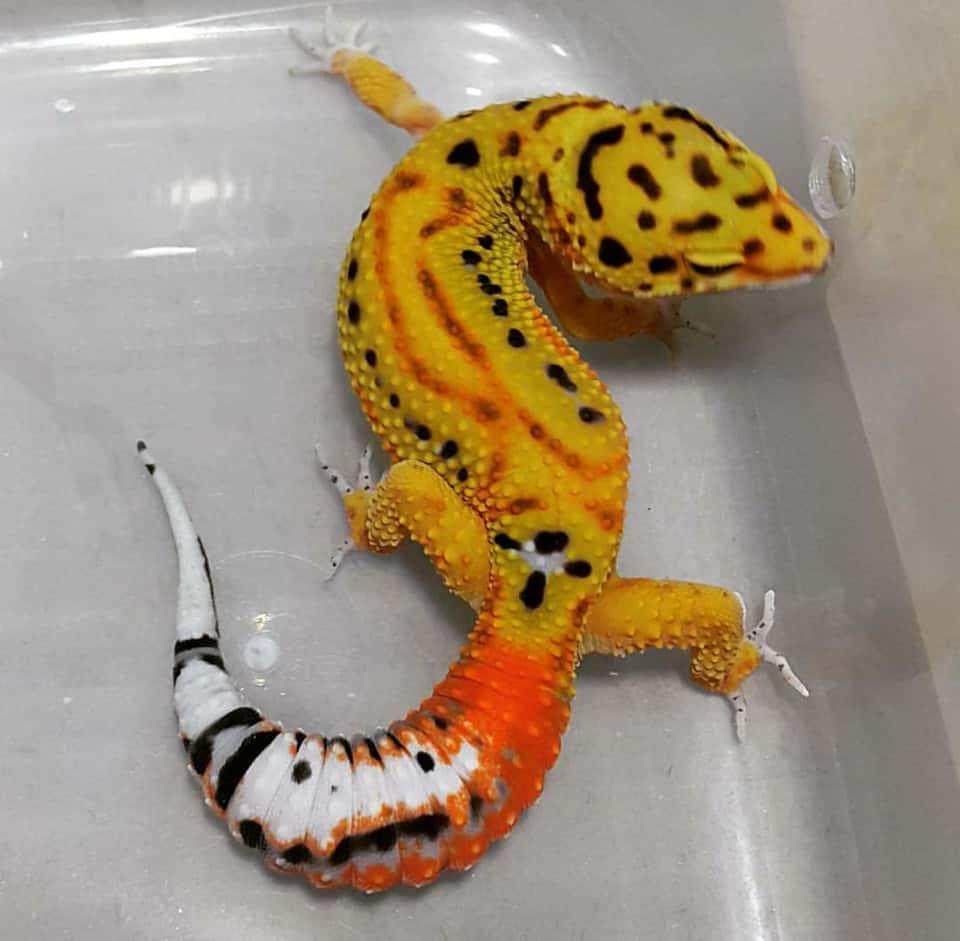
As the name suggests, carrot tail leopard geckos have bright orange on the base of their tail. The orange gradually fades to white with black markings, just like wild-type leopard geckos. Carrot tail is another line-bred trait.
SHTCTB (Super Hypo Tangerine Carrot Tail Baldy) is the only popular combination morph that includes the carrot tail trait.
Eclipse
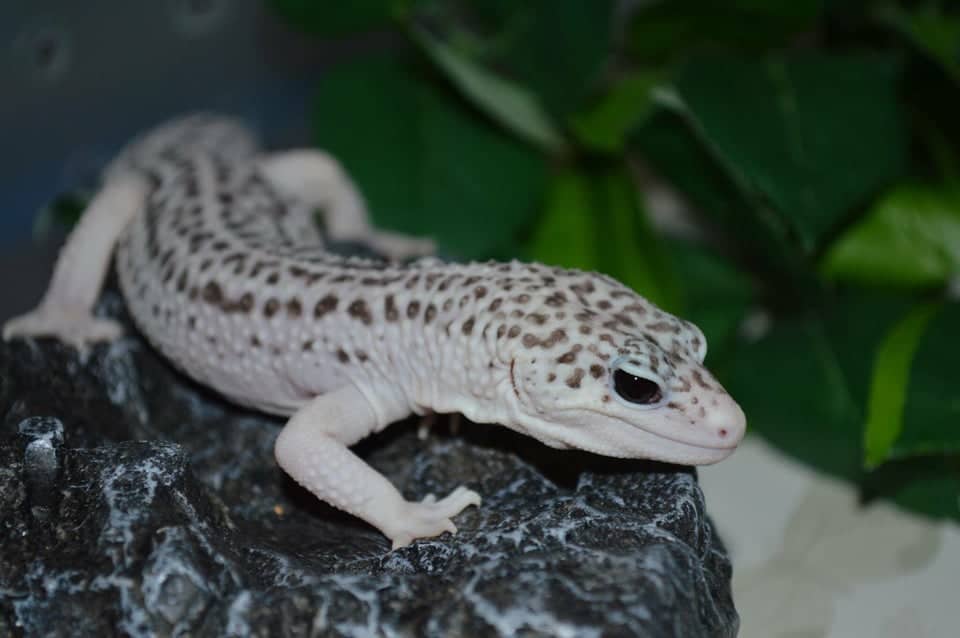
Eclipse is a highly unique, recessive, inheritable genetic mutation that causes several distinct characteristics, including:
- Speckles
- Washed-out colors
- Patternless stripe (sometimes)
- Black or clear eyes. Sometimes, the eye appears split: part black, part clear.
- White markings on nose, feet, and tail. High white eclipses may also have white on their neck and body.
The eclipse gene is used in numerous combination morphs, like:
- BEE (Eclipse + Enigma)
- Radar (Eclipse + Bell Albino)
- Raptor (Eclipse + Tremper Albino)
- Typhoon (Eclipse + Las Vegas Albino)
- Universe (Eclipse + Super Snow + W/Y)
- Nova (Eclipse + Tremper Albino + Enigma)
- Black Hole (Eclipse + Mack Snow + Enigma)
- White Knight (Eclipse + Bell Albino + Blizzard)
- Total Eclipse or Galaxy (Eclipse + Super Snow)
- Cyclone (Eclipse + Patternless + Las Vegas Albino)
- Diablo Blanco (Eclipse + Blizzard + Tremper Albino)
- Patternless Stripe (Possible heterozygous for Eclipse)
- Ember (Eclipse + Tremper Albino + Murphy Patternless)
- Aptor (heterozygous for Eclipse + Patternless + Tremper Albino)
- Snowflake (Eclipse + Mack Snow + Tremper Albino + Murphy Patternless)
Emerine
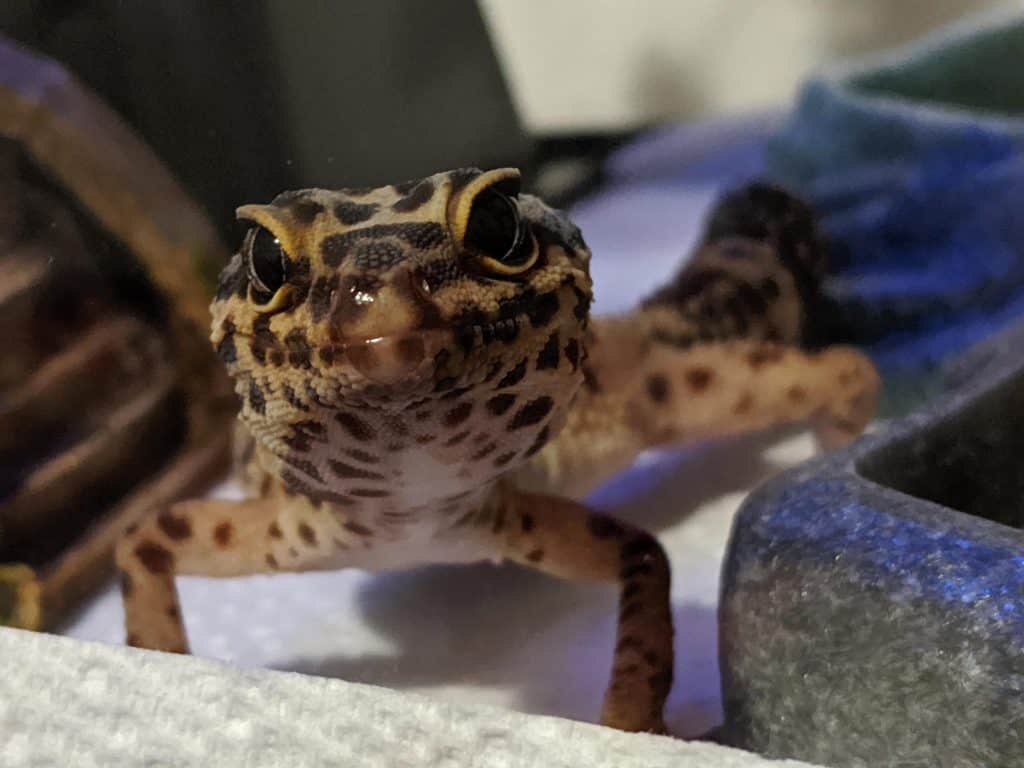
Emerine is a line-bred trait that was developed to produce leopard geckos with a more green coloration. This trait originated from the Tangerine trait.
There are many distinct bloodlines of emerine leopard geckos, but the most popular ones are:
- Clown
- G Project
- Pacific Green
- Blood Emerine
- Sykes Emerine
- Green & Tangerine
Enigma
The Enigma morph is a dominant genetic mutation that results in the pattern reducing down to speckles as the animal ages. Unfortunately, the gene is tied with neurological symptoms known as “enigma syndrome.”
Despite the health issues, the enigma morph is present in:
- BEE (Enigma + Eclipse)
- Nova (Enigma + Tremper Albino + Eclipse)
- Black Hole (Enigma + Eclipse + Mack Snow)
- Stealth (Enigma + Snow + Bell Albino + Eclipse)
- Super Stealth (Enigma + Super Snow + Bell Albino + Eclipse)
- Dreamsickle (Enigma + Tremper Albino + Eclipse + Mack Snow)
- Super Nova (Enigma + Tremper Albino + Eclipse + Super Mack Snow)
Ghost
Ghost is a dominant inheritable genetic mutation that results in faded colors or even shades of green. Ghost Leopard geckos are similar in appearance to hypo leopard geckos, but they are separate morphs. Ghost leos will never have the bright oranges and yellows that appear in hypo animals.
While this morph creates exciting results when combined with other morphs, there aren’t any names for these combinations (yet).
Giant
Giant is an incomplete dominant genetic mutation that results in a leopard gecko that is usually much larger than typical leopard geckos. Adult giant geckos are generally over 10 inches long, and super giant geckos are even longer.
Jungle giant is a unique bloodline of large leopard geckos with irregular spots and bands.
Hypomelanistic
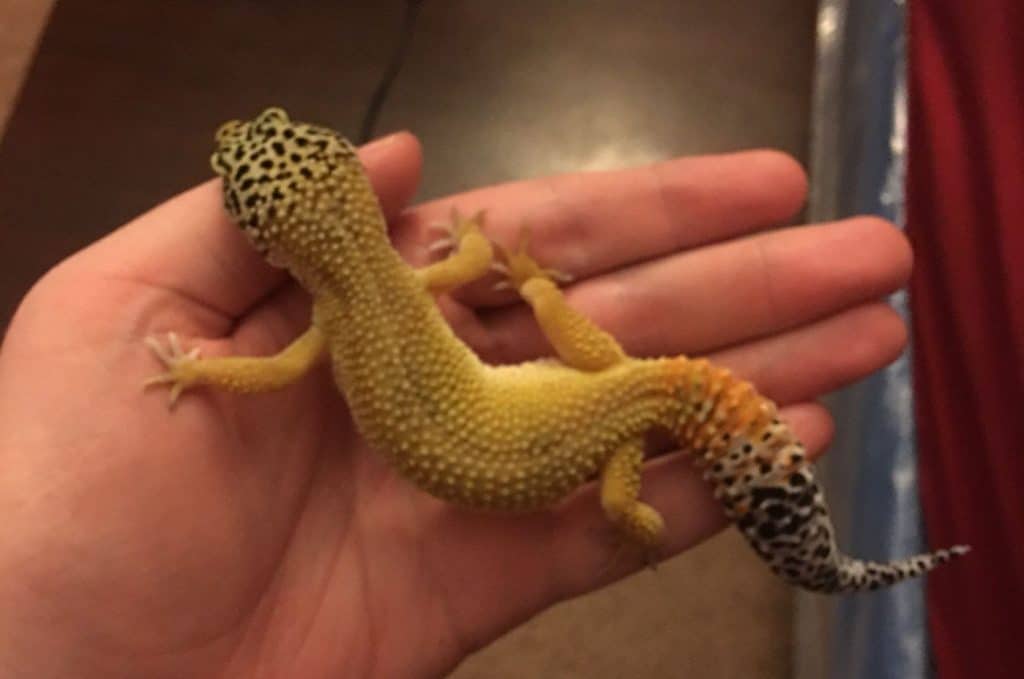
Hypomelanistic, commonly known as hypo, reduces the black pigmentation but does not eliminate it. Hypo is an incomplete dominant genetic mutation. Super hypo leopard geckos have no markings on their back.
SHTCTB (Super Hypo Tangerine Carrot Tail Baldy) is a common combination morph that utilizes the hypo gene.
The following morphs also make use of the muted, hypomelanistic coloration:
- Hybino (Hypo + Tangerine + Albino)
- Sunglow (Super Hypo + Tangerine + Albino)
- Blood Hypo (Hypo + Bloodline of the Tangerine trait)
Jungle
Jungle is a line-bred trait that results in irregular spots and connected spots that create bands.
Jungle giants are selectively bred for their large size, as well as their pattern.
Lavender
Lavender is a line-bred trait. Lavender leopard geckos have light purple undertones in their markings.
Two common bloodlines of lavender exist:
- Purple Head (Lavender + Tangerine)
- Lavender Bells (Lavender + Bell Albino)
Marble Eye
Marble eye is a recessive genetic morph that affects the eye color, similar to the eclipse morph. Unlike eclipse, marble eye doesn’t seem to change the body color or pattern. It also doesn’t change the background color of the eyes. Instead of white or clear, they have a marbled appearance.
Melanistic
Melanistic leopard geckos are line-bred to increase black coloration. Melanism in leopard geckos is, thus far, not a simple, inheritable genetic mutation.
Famous bloodlines of black leopard geckos are:
- Akoya
- Carbon
- Charcoal
- Black night
- Black pearl
NDBE
NDBE stands for Noir Desir Black Eye. It is a recessive, inheritable genetic morph.
This morph seems to be associated with the Gecko Genetics bloodline of Tangerine leopard geckos.
NDBE also intensifies the skin colors of the gecko. Surprisingly enough, NDBE females are infertile.
Pastel
Pastel is a line-bred trait that originated from the Raptor (Tremper Albion + Eclipse) morph. As the name suggests, pastel leopard geckos have soft, bright colors.
Patternless
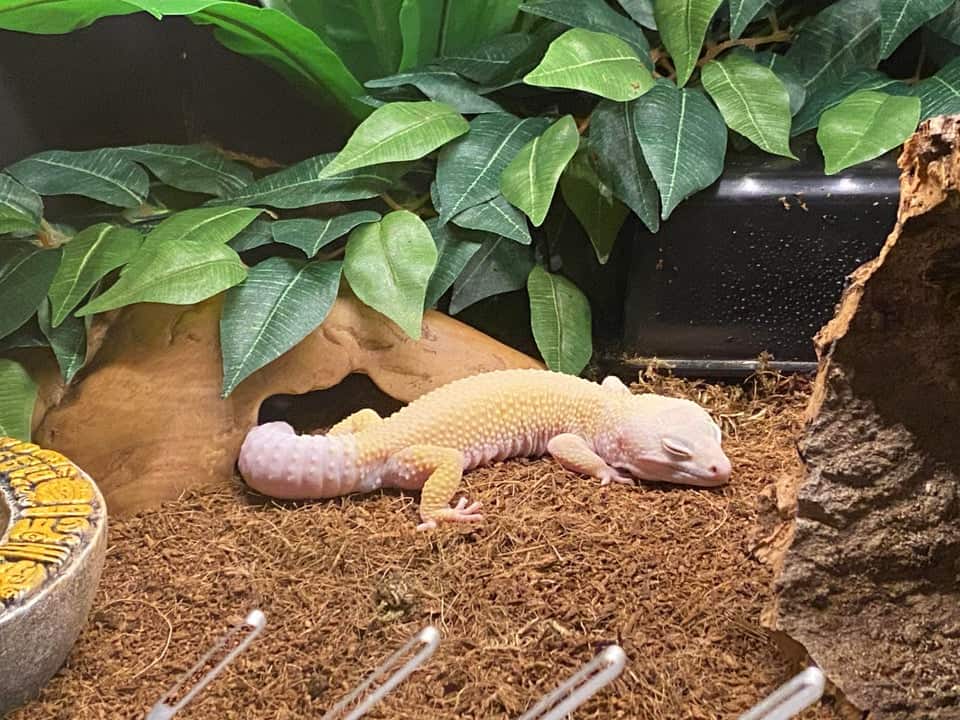
Also known as Murphy Patternless, this morph is a recessive genetic mutation.
It appears similar to the blizzard morph. Unlike blizzard hatchlings, murphy patternless leopard gecko hatchlings emerge with crazy, jungle-like patterns that fade with age.
Combination morphs that include patternless are:
- Banana Blizzard (Murphy Patternless + Blizzard)
- Ember (Murphy Patternless + Tremper Albino + Eclipse)
- Super Platinum (Murphy Patternless + Super Mack Snow)
- Cyclone (Murphy Patternless + Las Vegas Albino + Eclipse)
- Aptor (Patternless + Tremper Albino + heterozygous for Eclipse)
- Snowflake (Murphy Patternless + Mack Snow + Tremper Albino + Eclipse)
Snow
Snow is an incomplete dominant genetic mutation. Snow leopard geckos have black band borders. On wild-type leopard geckos, those borders are yellow. Super snow leopard geckos have solid-colored eyes and extreme speckling across their back.
There are at least three known lines of the snow morph:
- Gem snow
- TUG snow
- Mack snow
- Line bred snow
All of the lines appear to be compatible. That means you can breed a mack snow leopard gecko to a gem snow leopard gecko and end up with super snow babies.
Snow is one of the most widely-utilized morphs when creating combinations. Here are some of the popular blends:
- Creamsicle (Snow + Tangerine)
- Snowglow (Snow + Albino + Tangerine)
- Universe (Super Snow + Eclipse + W/Y)
- Black Hole (Mack Snow + Enigma + Eclipse)
- Total Eclipse or Galaxy (Super Snow + Eclipse)
- Stealth (Snow + Enigma + Bell Albino + Eclipse)
- Super Platinum (Super Mack Snow + Murphy Patternless)
- Super Stealth (Super Snow + Enigma + Bell Albino + Eclipse)
- Snowflake (Mack Snow + Tremper Albino + Murphy Patternless)
- Dreamsickle (Mack Snow + Tremper Albino + Eclipse + Enigma)
- Super Nova (Super Mack Snow + Tremper Albino + Eclipse + Enigma)
- Diorite (Super Snow + possible heterozygous for Blizzard or Murphy Patternless)
Stripe
Stripe is a line-bred trait that causes a stripe down the leopard gecko’s back.
There are many unrelated bloodlines and combinations that may result in animal with one or more stripes, including:
- Red Stripe
- Bold Stripe
- R2
- GGG
- Bandit
- Firebold
- Extreme Bold
- Halloween Mask
- Reverse Stripe
- Rainbow Stripe
- Eclipse (morph)
- Sykes Rainbow
- Patternless Stripe
- Raining Red Stripe (Rainwater Albino x Red Stripe)
Tangerine
Tangerine is one of the most prevalent line-bred traits in captive leopard geckos. It’s a catch-all term used to describe leopard geckos with more orange coloration than average.
There are dozens of tangerine bloodlines in existence today, but here are the most common ones:
- Blood
- Atomic
- Inferno
- Electric
- Mandarin
- Purple Head
- Tangerine Tornado
White & Yellow
This dominant genetic mutation results in a leopard gecko with a scarce black coloration. They have very few markings and almost entirely white tails and heads. This morph also causes a white stripe down the gecko’s back.
The Universe (W/Y + Super Snow + Eclipse) is one common combination morph that utilizes the White & Yellow, or W/Y, gene.
What Morph Is My Leopard Gecko?
There are so many bloodlines, combinations, and traits in leopard gecko morphs that it can be challenging to narrow down the genetics.
For breeding purposes, you should only use leopard geckos that you purchased with solid genetic background information.
Here are some general tips if you’re trying to identify the morph for fun or out of curiosity. It may help to compare your leopard gecko with a photo of a standard, wild-type leopard gecko.
Colors
- Yellow – Wild-type
- Purple – Lavender
- Black – One of the melanistic bloodlines
- White or pink – Albino, blizzard, W/Y, or snow
- Orange – One of the dozens of Tangerine bloodlines, carrot tail, or carrot head
Patterns
- Spots – Wild-type
- Irregular bands – Jungle
- Striped – Red stripe, eclipse, or reverse stripe.
- Speckled – Eclipse, diorite, super snow, or enigma
- Patternless – Murphy patternless or baldy (patternless head).
Size
- 5-8” – Wild-type
- Over 9”: Possibly giant or super giant
- Less than 6”: Juvenile or stunted growth
Dangerous Leopard Gecko Morphs
Unfortunately, some genetic leopard gecko morphs are tied to physical deformities and neurological issues. Experienced breeders may try to eliminate these conditions. Still, be wary when purchasing any of these morphs.
NDBE
The Noir Desir Black Eye gene sometimes causes minor eye deformities that typically do NOT affect the leopard gecko’s quality of life.
Enigma
This gene causes neurological issues known as “Enigma Syndrome” (ES). Symptoms include:
- Circling
- Wobbling
- Difficulty hunting
- Stargazing (staring upwards for extended periods)
Lemon Frost
Lemon Frost leopard geckos are prone to developing cancer as they mature. Other light-colored morphs, like hypo or pastel, seem to increase the likelihood of cancer developing.
How to Breed Leopard Gecko Morphs
Breeding leopard gecko morphs requires an understanding of the basic vocabulary and morph varieties.
Luckily, we’ve outlined all of that information for you above!
Breeding
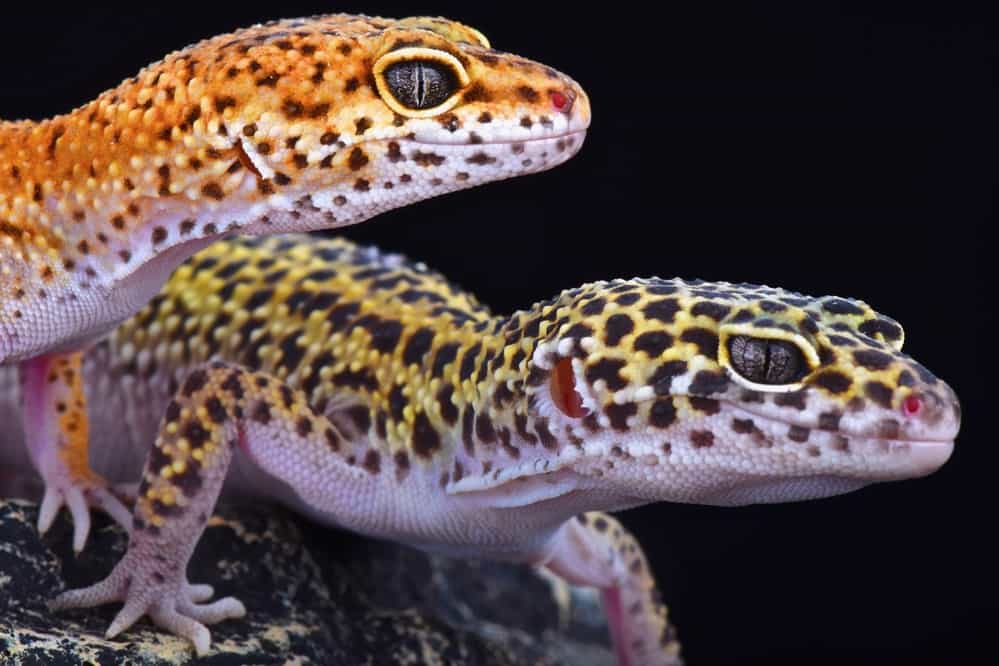
To breed leopard gecko morphs, you need to know how to breed normal leopard geckos.
Leopard geckos are ready to breed when they are 9 to 12 months old or weigh at least 45 grams.
The breeding season usually lasts from January to September.
Cooling the leopard geckos down to room temperature for about two months increases most breeders’ success rate. Withhold food starting 10 days before the cool-down, and don’t resume feeding until you warm them back up.
When you introduce the pair, the male may bite the female’s neck. Don’t panic! Biting is a normal part of the breeding process. You can separate your geckos as soon as they’re finished breeding. Re-introduce them to mate once a month.
The female will lay a clutch of two eggs two to three weeks after mating. She will continue to lay two eggs every two to three weeks over a four to five-month period, totalling 8 to 10 eggs per year.
Construct a nesting box by cutting an appropriately-sized entry hole in a plastic container with a lid. Ensure there are no sharp edges. Fill it with a damp substrate, like peat moss or vermiculite.
Once the female lays the eggs, incubate them at 80-90°F for one to three months.
Genetics and The Punnett Square
Now that you know the basics of breeding your leopard geckos, you’ll need to learn about genetics and inheritability.
Become familiar with the vocabulary words and morph characteristics above. Pay special attention to the morph or combination morph that you’re hoping to breed. Is the gene dominant? Recessive?
To breed hatchlings with a dominant morph, only one parent needs to have the morph. If both parents have the morph, your chances will be even higher.
To breed babies with a recessive morph, both parents need to be heterozygous for the morph. If one or both parents are homozygous for the morph, meaning they show it, your chances will be even higher.
The Punnett Square is a valuable tool for determining likely offspring outcomes. Another helpful gadget is this leopard gecko morph calculator.
Just remember: sometimes, nature has a mind of its own. You could end up with a new morph or no morph at all!
Getting Ready for Your Unique Leopard Gecko
Whether you’re breeding or buying your hatchling leopard geckos with morphs, be sure to check out our baby leopard gecko care guide.
Don’t forget to set up the perfect leopard gecko habitat before your new pet arrives.
After all, setting up its enclosure well will significantly contribute to prolonging your leopard gecko’s lifespan.
